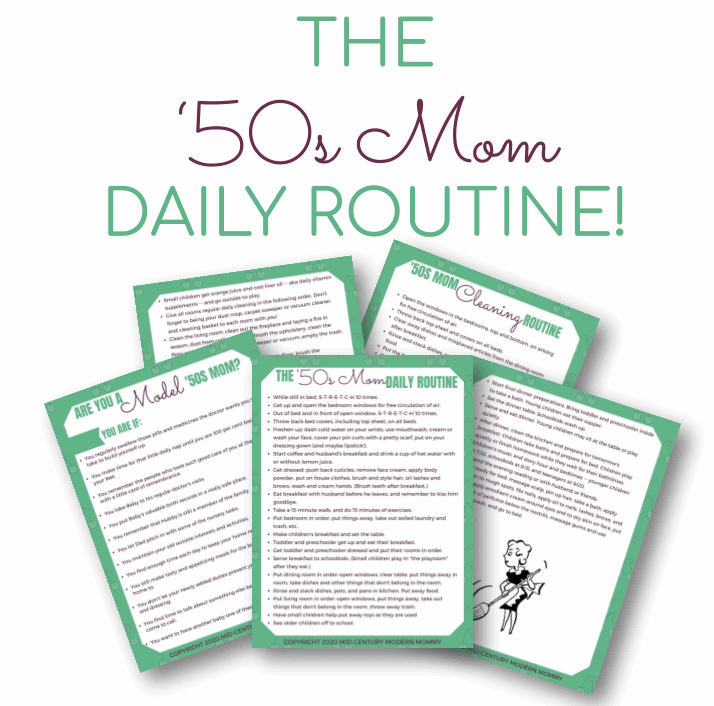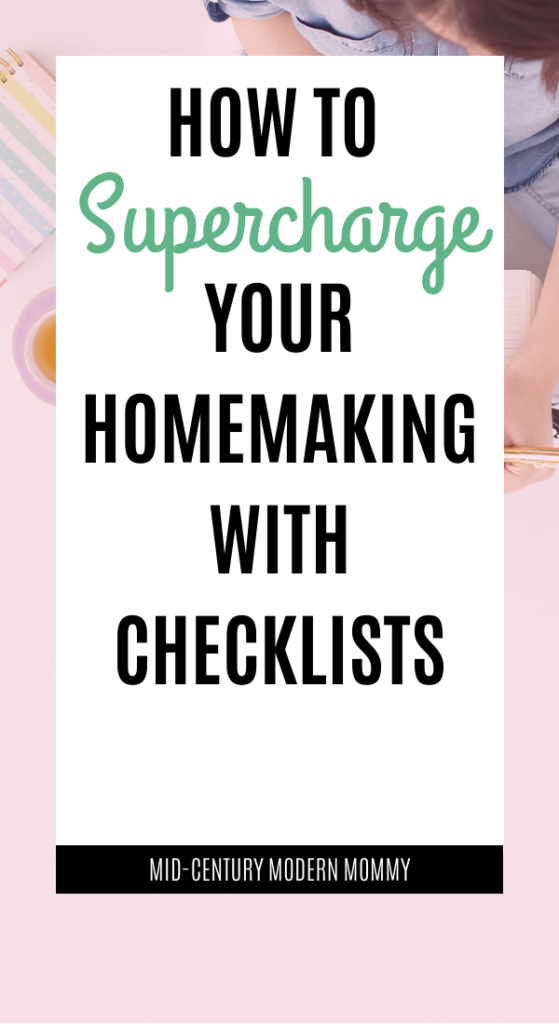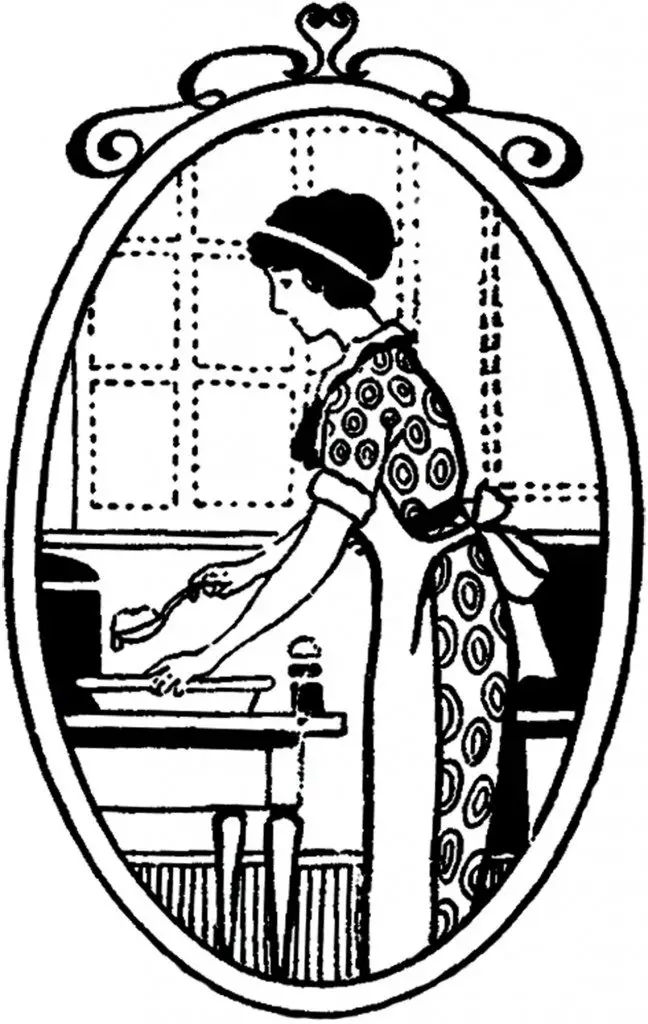Let me tell you a secret: I can’t use lesson plans in my homeschool. There are too many kids doing too many things for me to have lessons planned out that I need to teach. I need to spend my time keeping the house neat, clean, and fresh! Finally, I found a solution to help me organize my homeschool assignments and motivate my children, as well as my manage my homemaking. Here’s how to use checklists in your home (and homeschool) management, and still use a schedule!

Get Our Mid-Century Mom Daily Routine FREE!
This post contains affiliate links. If you click a link and make a purchase, I may receive, at no additional cost to you, a small commission. Find out more on my Disclosures page, and thank you so much for your support!
Why You Need Homemaking Checklists
So, here is how it usually works with my lesson plans. I spend WEEKS looking up books, information, lesson procedures, schedules, curriculum plans, notebooking pages. Then, I spend more weeks planning it all out, writing every day’s plan in neat little boxes for the year, subject by subject (5 kids times 7 subjects equals 35 yearly plans, BTW.) I have visions of everything turning out just right. Then, we start school. And, without fail, something interrupts the first week, we take a day off and take care of it, and the entire lesson plan is off. (Usually harvesting something. September in a farmhouse, y’all.) And I am too much of a perfectionist to be OK with being a day off. I HATE IT! Plus, the systems break down unless I am teaching the lessons. And that doesn’t leave me any time to do my own work.
Plus, I needed a system that worked with our daily schedule. I firmly believe in schedules. Everything that needs to be done is done with a schedule. Mostly, that is because I can stop keeping track of what everyone needs to be doing — they can just look for themselves. Also, two of my kids, in particular, need a definite daily schedule that repeats over and over. (So do I!) Especially with another little one on the way, homeschooling five children at different levels this year needs to have a simplified system. Enter, the checklists!
The Value of a Good List
There are a few reasons why my simplified system uses checklists. First, with checklists, things are completed and not forgotten. Second, checklists free up my brain to think and plan and discuss things with my family. Finally, checklists are a vital part of teaching children to be self-reliant, independent, and motivated.
If you watched Tidying Up with Marie Kondo on Netflix, you might remember the mom who had to remember where everything was for everyone in the family. Even though it was a small apartment, people constantly asked her where their things were — and she put a great deal of energy into remembering for them. I have a lot more time and energy when I don’t have to remember everything for everyone, and they are responsible for their own things and their own selves. Part of my job as their mother and their teacher is to teach them how to take care of themselves, how to learn the things they need to learn, and how to work hard and be a good person — even when they do not want to. That starts by creating a schedule when they are little that combines with instruction and household organization to teach them regularity and orderliness. The checklists remind them of what they need to do each day. The schedule sets blocks of time for them to accomplish the tasks.

My Checklists
I use a few different kinds of checklists in my homeschool. First, I have the subject checklists. These checklists are record sheets for our homeschool, as well as future planners. I also have weekly checklists, which have things like exercise, chores, music practice, handwork practice, etc. Finally, I have routine checklists, which have step-by-step checklists of things like grooming and hygiene routines, or daily and weekly cleaning chores. I even have these routine checklists for things like making dinner and breakfast. Anyone can follow my checklists to get approximately the same result. Some of these come from my homemaking system, where I use a lot of routine checklists. My cleaning schedule and my own daily work are in the form of routine checklists.
All of these checklists work really well with scheduling. There is a set amount of time each day assigned to a particular task. Within that time, you get as much done on your checklist for that task as possible. If you finish your checklist early, you have some free time. When you don’t get everything done, then either you move the low priority items further down the checklist, or you pick up where you left off the next day — or both! A good schedule provides the structure to make routine checklists work.
Subject Checklists
There are lists for early learning, math, writing, reading, language arts, handwork, and practical life skills. Each of these lists is laid out slightly differently, but they all follow the same format: a list of lessons to complete, and then spaces for each step in the procedure for that subject that are checked off for that lesson.
For example, the Math Record Sheet records the number of the lesson, the description of the lesson, the date the lesson was started, the date completed, the number of times the lesson was attempted, and the final grade. The date completed isn’t filled in until the lesson is passed. (90% or higher in our house.) The Practical Life Skills Record Sheet includes a description of the activity, date taught, date child can do the activity independently, and date mastered. Most of the Record Sheets are for the children over 10. The Early Learning Record Sheet has 2 parts: Before Age 6 and 6-10. Those sheets consolidate all the subjects for those age groups.
To use the subject checklists, I have the children record their work every day. They are required to do a minimum amount during the scheduled time, or they have to finish the minimum in their free time. At the end of the week, I fill in the record sheets for the week, so that I have a record for the school district. For my record keeping, I have a set of record sheets for each child, a goal sheet and IEP for each child, a calendar for the current school year, the terms and their holidays, and a calendar from the school district showing their important dates. I also have my Curriculum Handbook, which consists of my Course of Study, Subject Procedures, and Extracurriculars, which explains my educational plans, goals, and philosophy, as well as what to teach and how for each subject.
Weekly Checklists
Weekly checklists are fairly common among homeschoolers. Mine has space to write down the completed lessons, as well as space to mark off chores and other responsibilities. The child also develops a sense of independence and personal responsibility.
Another thing we do weekly is to use habit cards. Habit cards are character training tools. Every week, I choose a virtue, habit, or manner that I want the child to work on. I write down exactly what that looks like, in terms of behaviors and actions. Then, the children practice their habits all week. If they get to the end of the week, and they have accomplished all of their habit cards and responsibilities, there is an outing, an event, or another reward.
During the week, if they struggle with me about checklists or habit cards, whatever free time and outside influences they have are likely to be curtailed until their attitude improves. I am a firm believer in “shortening the leash” for a child that is acting badly. Even my teenagers have to behave well to get time in their rooms by themselves.
Routine Checklists
Routine checklists are a beautiful thing! Most importantly, they take a load off of my mind. I don’t have to remember every step in every chore; I can direct people to the appropriate list. Routine checklists are also good for inspections. The children know exactly what I consider to be done, and done well.
I use a morning routine and evening routine checklist, and my daily routine checklist, divided into sections so that it can correspond to my schedule. I get up in the morning, look at my checklist, and see exactly what I need to do before my brain wakes up. At cleaning time, I follow my lists step-by-step until everything is done. Then, I follow my meal plans the same way. My teenage daughter can follow them as well as I can; she gets the same results. (The others are learning!)
I also have picture cards for the chores and responsibilities that my youngest children do. They use the visuals as cues for their routines. I start training for orderliness and obedience when they are toddlers. A lot of training time goes to hands-on training. As the children grow, I don’t need to watch or train as closely. The children have morning and evening routines. They also have a routine for their schoolwork, based on our Procedure List. Essentially, they go through a routine checklist for each subject. They need to finish the checklist in the time allotted for that subject on a daily or weekly basis. The checklists cover procedures for math, language arts, and reading on a daily basis. Skills need daily practice for mastery.
Combining with Schedules
The most important part of my checklist system is how it works with my schedule. My schedule is fairly strict. We switch activities with the times listed on the schedule. But, during that time, our checklists are a guide to the best way to get things done. Combining schedules and checklists allows me to change either one as needed without too much disruption.
If I need to spend a whole day packaging meat (butchering day!), I can pull out the most important lists and get those done first, then spend the rest of the day “off schedule.” Meanwhile, my children can continue with their schedules and routines. The important things still get done, but there is time for the needs of the farmer’s wheel of the year.
The same thing happens on Sunday. Sunday is our sabbath, so it is more relaxed, with a midday dinner and Sunday supper. We spend time together, worship together, and celebrate together. Then, we pick up again on Monday.
This system works really well for our family. I recommend starting with a schedule and routine checklists. Both of those are a good way to start organizing your home and homeschool management.




